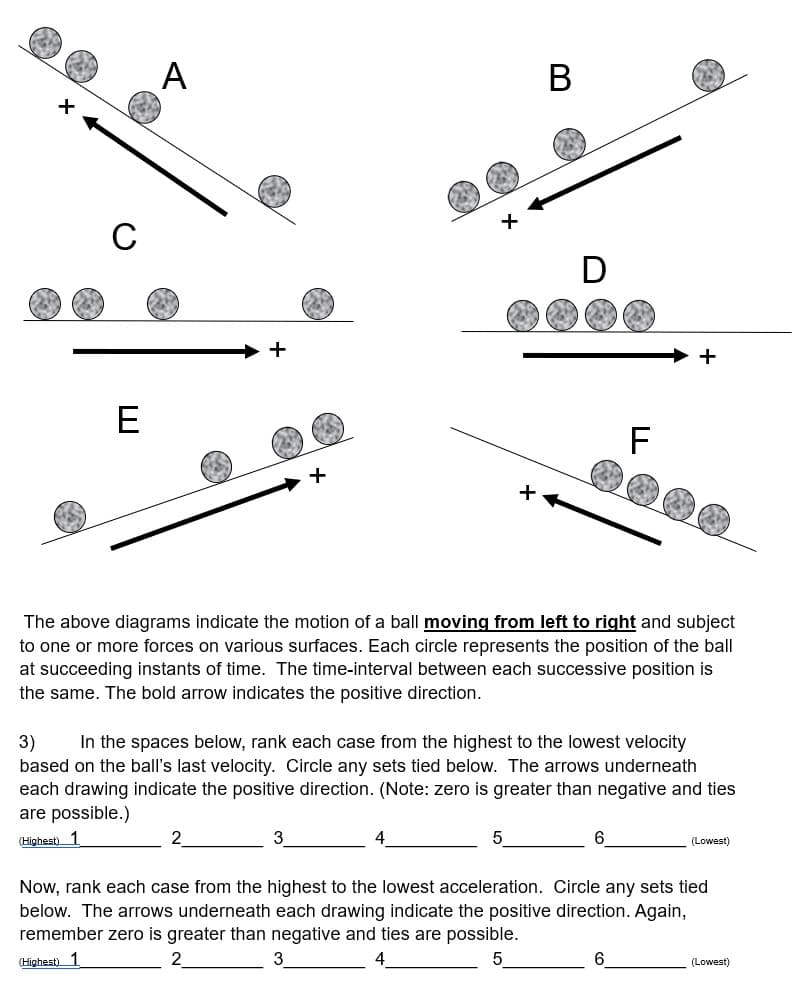+ C E A + 2 3 The above diagrams indicate the motion of a ball moving from left to right and subject to one or more forces on various surfaces. Each circle represents the position of the ball at succeeding instants of time. The time-interval between each successive position is the same. The bold arrow indicates the positive direction. B 3) In the spaces below, rank each case from the highest to the lowest velocity based on the ball's last velocity. Circle any sets tied below. The arrows underneath each drawing indicate the positive direction. (Note: zero is greater than negative and ties are possible.) (Highest) 1 4 D 5 FL 6 (Lowest) Now, rank each case from the highest to the lowest acceleration. Circle any sets tied
+ C E A + 2 3 The above diagrams indicate the motion of a ball moving from left to right and subject to one or more forces on various surfaces. Each circle represents the position of the ball at succeeding instants of time. The time-interval between each successive position is the same. The bold arrow indicates the positive direction. B 3) In the spaces below, rank each case from the highest to the lowest velocity based on the ball's last velocity. Circle any sets tied below. The arrows underneath each drawing indicate the positive direction. (Note: zero is greater than negative and ties are possible.) (Highest) 1 4 D 5 FL 6 (Lowest) Now, rank each case from the highest to the lowest acceleration. Circle any sets tied
Glencoe Physics: Principles and Problems, Student Edition
1st Edition
ISBN:9780078807213
Author:Paul W. Zitzewitz
Publisher:Paul W. Zitzewitz
Chapter6: Motion In Two Dimensions
Section: Chapter Questions
Problem 92A
Related questions
Topic Video
Question

Transcribed Image Text:Fo
C
E
A
+
2
+
3
B
The above diagrams indicate the motion of a ball moving from left to right and subject
to one or more forces on various surfaces. Each circle represents the position of the ball
at succeeding instants of time. The time-interval between each successive position is
the same. The bold arrow indicates the positive direction.
4
D
3) In the spaces below, rank each case from the highest to the lowest velocity
based on the ball's last velocity. Circle any sets tied below. The arrows underneath
each drawing indicate the positive direction. (Note: zero is greater than negative and ties
are possible.)
(Highest) 1
5
F
6
+
6
(Lowest)
Now, rank each case from the highest to the lowest acceleration. Circle any sets tied
below. The arrows underneath each drawing indicate the positive direction. Again,
remember zero is greater than negative and ties are possible.
(Highest) 1
2
3
4
5
(Lowest)
Expert Solution
This question has been solved!
Explore an expertly crafted, step-by-step solution for a thorough understanding of key concepts.
Step by step
Solved in 4 steps with 4 images

Knowledge Booster
Learn more about
Need a deep-dive on the concept behind this application? Look no further. Learn more about this topic, physics and related others by exploring similar questions and additional content below.Recommended textbooks for you

Glencoe Physics: Principles and Problems, Student…
Physics
ISBN:
9780078807213
Author:
Paul W. Zitzewitz
Publisher:
Glencoe/McGraw-Hill

University Physics Volume 1
Physics
ISBN:
9781938168277
Author:
William Moebs, Samuel J. Ling, Jeff Sanny
Publisher:
OpenStax - Rice University

Glencoe Physics: Principles and Problems, Student…
Physics
ISBN:
9780078807213
Author:
Paul W. Zitzewitz
Publisher:
Glencoe/McGraw-Hill

University Physics Volume 1
Physics
ISBN:
9781938168277
Author:
William Moebs, Samuel J. Ling, Jeff Sanny
Publisher:
OpenStax - Rice University